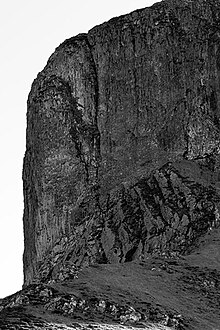
Pitchstone is a dark coloured, glassy volcanic rock formed when felsic lava or magma cools quickly. Since it is a volcanic glass, pitchstone may have a conchoidal fracture. Pitchstones may also contain phenocrysts, in which case it is a form of vitrophyre. Pitchstone has a resinous lustre, or silky in some cases, and a variable composition. Its colour may be mottled, streaked, or uniform brown, red, green, gray, or black. It is an extrusive rock that is very resistant to erosion. [1]
The pitchstone ridge of An Sgùrr on the Isle of Eigg, Scotland, was possibly formed as a lava flow in a valley. [2]
Pitchstone from the Isle of Arran was used as the raw material for making various items from the Mesolithic through the Neolithic to the Early Bronze Age. [3] Mesolithic use appears to have been limited to the Isle of Arran itself, while in later periods the material or items made from it were transported around Britain. [3]
References
- ^ Troll, Valentin R.; Emeleus, C. Henry; Nicoll, Graeme R.; Mattsson, Tobias; Ellam, Robert M.; Donaldson, Colin H.; Harris, Chris (2019-01-24). "A large explosive silicic eruption in the British Palaeogene Igneous Province". Scientific Reports. 9 (1): 494. Bibcode: 2019NatSR...9..494T. doi: 10.1038/s41598-018-35855-w. ISSN 2045-2322. PMC 6345756. PMID 30679443.
- ^ Emeleus, C.H. (1997). Geology of Rum and the adjacent islands : memoir for 1:50000 geological sheet 60 (Scotland). London: Stationery Office. ISBN 0118845179.
- ^
a
b Ballin, Torben Bjarke (2015).
"Arran pitchstone (Scottish volcanic glass): New dating evidence". Journal of Lithic Studies. 2 (1).
University of Edinburgh: 5–16.
doi:
10.2218/jls.v2i1.1166.
hdl:
10454/9048.
